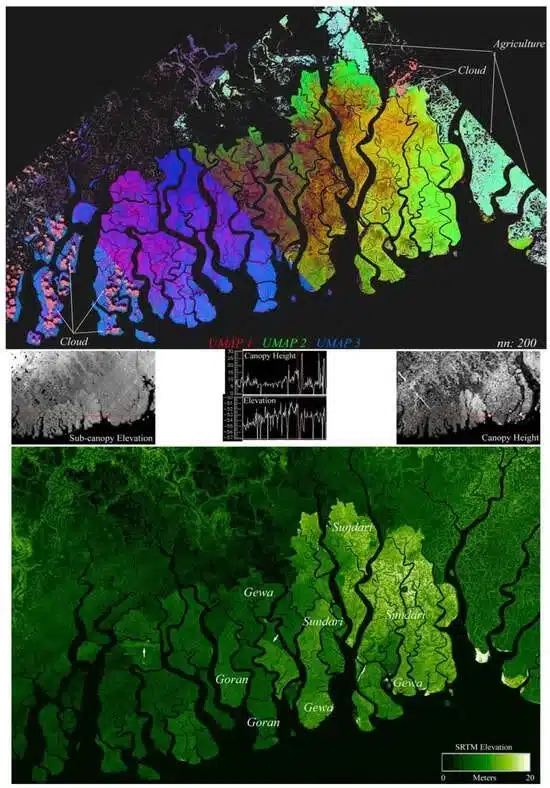Key Facts Summary
- AI analyzes satellite imagery in real-time to detect deforestation and illegal logging, enabling swift enforcement responses
- Machine learning algorithms process drone data to monitor individual tree health, identify diseases, and track reforestation progress
- Payment for ecosystem services programs use AI to verify that financial incentives effectively prevent deforestation
- AI-powered wildfire prediction models analyze over 400 variables to optimize resource allocation and reduce emergency response times
- Between 2015 and 2020, over 10 million hectares of forests disappeared annually, making AI-driven monitoring essential for conservation
Forests function as Earth’s respiratory system, providing clean air, purifying water sources, and supporting biodiversity. Yet between 2015 and 2020, more than 10 million hectares of forest vanished each year. This accelerating destruction creates a destructive feedback loop that intensifies climate change, pushes species toward extinction, and undermines ecosystems that sustain millions of people. AI technology now offers powerful tools to reverse this trend by detecting deforestation, monitoring forest health, and optimizing conservation strategies.
Traditional forest monitoring methods struggle with scale and speed. Satellite analysis can take weeks, while ground surveys cover limited areas. Machine learning algorithms now process vast datasets from satellites and drones within hours, identifying threats before they escalate. This technological shift enables authorities to protect forests more effectively while supporting sustainable management practices that balance ecological preservation with economic needs.
Real-Time Deforestation Detection Through Satellite Analysis
Monitoring vast forest territories presents enormous challenges. Traditional remote sensing methods consume significant time and resources. AI-powered systems revolutionize this process by analyzing satellite imagery continuously, detecting changes in forest cover as they occur. These systems alert authorities within hours of detecting illegal logging or unauthorized land clearing, allowing rapid intervention.
Brazil demonstrates the effectiveness of this approach through its Amazon monitoring system. Machine learning algorithms process satellite data to track illegal logging activities across millions of hectares. This technology substantially improves enforcement capabilities, protecting one of the planet’s most vital ecosystems. The system identifies suspicious clearing patterns, distinguishes between authorized and illegal activities, and prioritizes areas requiring immediate attention.
The technology operates by comparing historical forest cover data with current imagery. Algorithms detect subtle changes in vegetation density, canopy structure, and land use patterns. When anomalies appear, the system generates alerts with precise geographic coordinates, enabling ground teams to investigate and respond quickly. This rapid detection capability transforms forest protection from reactive to proactive management.
Drone Technology for Precision Forest Monitoring
Drones equipped with AI capabilities provide detailed insights impossible to obtain from satellites alone. These unmanned aerial vehicles capture high-resolution imagery of individual trees, enabling assessment of forest health at unprecedented granularity. In Canada, forestry operations deploy drones to monitor post-logging recovery efforts, tracking reforestation progress and evaluating new growth health.
Drone-collected data reveals information critical for effective forest management. AI algorithms analyze this imagery to identify healthy trees, detect damaged specimens, and locate deadwood. The technology measures tree height, diameter, and crown density, providing quantitative metrics for forest inventory. This granular data supports decisions about harvesting, planting, and conservation priorities.
The combination of drone imagery and machine learning enables early disease detection. Algorithms recognize visual signatures of pest infestations, fungal infections, and stress conditions before symptoms become obvious to human observers. Early intervention prevents disease spread, protecting entire forest stands from devastation. This predictive capability saves both ecological and economic resources.
Disease Detection and Tree Health Assessment
Forest diseases spread rapidly when left undetected. AI systems trained on thousands of images recognize disease symptoms across diverse tree species. The technology analyzes leaf discoloration, bark abnormalities, branch dieback, and other indicators of poor health. By processing multispectral imagery, algorithms detect stress signals invisible to the naked eye, including changes in chlorophyll content and water absorption patterns.
This diagnostic capability extends beyond individual trees to population-level monitoring. AI tracks disease progression across forest landscapes, predicting outbreak patterns and identifying areas at highest risk. Forest managers use these insights to implement targeted treatments, quarantine affected zones, and prevent epidemics. The approach reduces chemical use by enabling precise application only where needed.
Verifying Conservation Payments with AI
Payment for ecosystem services programs incentivize landowners to protect forests through financial rewards. These programs require robust monitoring to ensure payments achieve conservation goals. AI provides the verification mechanism that makes these programs viable at scale.
GainForest.Earth exemplifies this approach. The organization combines satellite imagery analysis with community-collected data to track forest cover changes over time. Machine learning algorithms compare protected areas with control groups, measuring program effectiveness objectively. This data-driven methodology ensures payments reach landowners who genuinely protect forests, creating accountability and transparency.
The system identifies deforestation hotspots and allocates resources accordingly. By analyzing patterns across multiple regions, AI helps optimize payment structures, determining which incentive levels produce the best conservation outcomes. This evidence-based approach maximizes environmental impact per dollar invested, making conservation programs more sustainable and effective.
Decentralized data collection empowers local communities to participate in monitoring efforts. Community members upload observations through mobile applications, contributing valuable ground-truth data that satellites cannot capture. AI synthesizes these diverse data streams, creating comprehensive forest health assessments that inform both conservation strategy and payment distribution.
Optimizing Reforestation Strategies
Successful reforestation requires careful planning based on soil conditions, climate patterns, and ecosystem composition. AI analyzes historical forest data to predict which species thrive in specific locations. Machine learning models consider factors including rainfall, temperature ranges, soil chemistry, and existing vegetation to recommend optimal planting strategies.
The technology evaluates reforestation progress by tracking seedling survival rates and growth patterns. Algorithms process time-series imagery to measure vegetation recovery, comparing actual outcomes against projections. When plantings underperform, AI identifies contributing factors such as inadequate water, pest pressure, or unsuitable species selection, enabling corrective action.
This analytical capability extends to biodiversity monitoring. AI-powered acoustic sensors identify bird calls, animal vocalizations, and insect sounds, providing indicators of ecosystem health. Increasing species diversity signals successful habitat restoration, while declining acoustic activity warns of problems requiring attention. These automated monitoring systems operate continuously at minimal cost, generating rich datasets that inform adaptive management.
Wildfire Risk Management and Prevention
Wildfires have burned naturally for millions of years, maintaining healthy forest ecosystems. However, climate change makes fires more frequent, larger, and destructive. Since 2000, the United States experienced approximately 1.5 million wildfires, burning an average of 7 million acres annually compared to 3.3 million acres yearly in the 1990s. California wildfires in 2020 alone consumed over 4 million acres, releasing nearly 127 million tonnes of carbon dioxide equivalent.
AI and machine learning demonstrate immense potential for wildfire response. Computer vision advances driven by autonomous vehicle development now apply to wildfire prediction science. Natural language processing improvements enhance prediction model accuracy. These technological capabilities combine with advanced data collection methods to support firefighting and risk management.
Early Detection and Alert Systems
Forest sensors equipped with AI collect acoustic information and function as smoke detectors, alerting authorities within the first hour of wildfire ignition. This rapid response window proves critical for containment. Unmanned aerial vehicles fly over active fires providing live imagery that helps firefighters plan effective responses.
Two programs in the United States provide near-live fire information. Google employs geostationary satellites to produce real-time fire maps. NASA’s Fire Information for Resource Management system uses low-orbit satellites with software that detects wildfires with just 60 seconds lag between Earth observation and detection.
The FireAId Initiative in Turkey
The FireAId initiative piloted with Koç Holding in Turkey following the country’s worst recorded wildfires in July and August 2021, when 139,503 hectares burned. Developed in collaboration with the Turkish Ministry of Agriculture and Forestry, the program focused on South Aegean and West Mediterranean regions covering 44,000 square kilometers. One quarter of Turkey’s wildfires originate in this region, accounting for 75 percent of total burned area between 2010 and 2021.
The project proceeded in two phases. First, dynamic and static datasets created a risk map categorizing ignition probability and severity. Second, the risk map informed a resource allocation model for efficient firefighting deployment. The initiative analyzed more than 400 variables using advanced AI models, successfully predicting wildfire risks and optimizing firefighting resource use.
| AI Application | Technology Used | Primary Benefit |
| Deforestation Detection | Satellite imagery analysis with machine learning | Real-time alerts enable rapid enforcement response |
| Tree Health Monitoring | Drone imagery with multispectral sensors | Early disease detection prevents outbreak spread |
| Conservation Payment Verification | Time-series satellite analysis with community data | Ensures payments reach effective conservation programs |
| Wildfire Risk Prediction | Multi-variable analysis with predictive modeling | Optimizes firefighting resource allocation |
| Reforestation Planning | Growth pattern analysis with species modeling | Improves seedling survival and ecosystem recovery |
According to Levent Çakıroğlu, Chief Executive Officer of Koç Holding, “We are willing to work with all interested stakeholders, international organizations and especially countries that are vulnerable to wildfires. In terms of scaling, we want to underline that this is a non-commercial product. We can share our algorithms and source codes for further improvements. We have already started to work on scaling the pilot to cover all regions in Turkey as the next step. In parallel, we are eager to work with data providers and piloting partners across the world. We must all unite in an effort to save our forests, our common future, our world.”
Deloitte joined the FireAId initiative in June 2022, developing forecasting models and a scenario engine with an intuitive user interface. The organization collaborates with NVIDIA to create digital twin simulations for firefighters, allowing them to plot fire progression and evaluate response strategies. David Thogmartin, Director of AI and Data Analytics at Deloitte Risk Advisory, notes: “Wildfires represent a growing environmental problem. Intervention measures are more effective the earlier they are taken – saving lives, livelihoods, habitats, as well as the cost of the measures themselves. While a significant modelling challenge, better prediction of fire outbreak and spread – using technologies such as AI, cloud and digital twins – has the potential to upgrade resource planning and save firefighters valuable time.”
Wildfire Impact on Water Resources
Forest lands provide the majority of freshwater supplies. In the United States, forests supply 80 percent of total freshwater. Wildfires severely damage water quality in rivers, reservoirs, and streams. Ash settles on water surfaces while burned landscapes erode more quickly, increasing sediment accumulation. After fires, soil loses capacity to absorb and store water, raising flood risk.
Managing and preventing wildfires constitutes a vital element of climate change control and habitat protection. The FireAId pilot provides hope that progress continues. Existing data and past wildfire studies lay solid foundations for future development.
International Collaboration Requirements
Project workshops emphasize the need for international cooperation to develop AI-driven forest protection initiatives. Experts stress several critical requirements for success. First, compatible and relevant data sharing proves essential for developing effective AI fire-prediction models. Second, historical data requires supplementation with new real-time information sources. Third, existing controlled burn methods need development to prevent, manage, and limit wildfires through strategic fire use.
The FireAId initiative provides inspiration for future development teams and focuses global engagement among climate technology leaders in industry and government. Cooperation should concentrate on developing AI and machine learning applications for wildfire risk management and mitigating other climate risks that threaten natural environments, populations, and economic prosperity.
Bekir Karacabey, General Manager at the Turkish Ministry of Agriculture and Forestry, states: “With the wildfire risk mapping and logistic planning project, in which Koç Holding’s advanced analytics and artificial intelligence capabilities and our know-how have combined, we have incorporated new technological advancements into our organization. Prior to this, only meteorological variables were used in risk mapping, but as of now static and meteorological datasets are combined. In addition, response time is one of the critical metrics in firefighting. The logistic planning part of the project enables us to reduce response time with less risk. We have been working on extending our pilot [throughout] Türkiye. We believe that extending FireAId to other fire-prone countries with the support of the World Economic Forum will help the fight against wildfires.”
Addressing Data Reliability and Privacy
AI empowers citizen science by providing tools that allow anyone to collect and submit environmental data, contributing to comprehensive forest health understanding. This fosters community involvement and develops equitable technology serving nature while supporting global conservation. However, data reliability and privacy concerns require careful attention.
Quality control mechanisms ensure citizen-collected data meets scientific standards. AI algorithms identify anomalous submissions, flag potential errors, and cross-reference observations with other data sources. Training programs educate volunteers on proper data collection methods, improving overall dataset quality. Privacy protections prevent misuse of location data while maintaining transparency about forest conditions.
Future Directions for AI in Forestry

Image credit: https://www.mdpi.com/2072-4292/16/15/2796
AI technology for forest management continues evolving rapidly. Emerging capabilities include improved species identification, automated invasive plant detection, and carbon sequestration modeling. Integration with climate models enables prediction of how forests respond to temperature changes, precipitation shifts, and extreme weather events.
Government ministries must respond to funding needs, modernizing departments and upgrading equipment. Adequate budgets enable adoption of AI systems that multiply the effectiveness of existing personnel. Investment in these technologies delivers returns through reduced firefighting costs, preserved ecosystem services, and avoided climate damages.
The path forward requires collaboration among technology developers, forestry professionals, conservation organizations, and government agencies. Sharing data, methodologies, and insights accelerates progress toward sustainable forest management. AI provides tools to protect forests at the scale and speed necessary to address current threats, but success depends on coordinated action across sectors and borders.
Conclusion
AI transforms forest conservation from reactive crisis management to proactive protection. Satellite monitoring detects deforestation in real-time, enabling swift enforcement. Drone technology provides detailed tree health assessments, supporting early disease intervention. Machine learning verifies conservation payment effectiveness, ensuring resources reach programs that work. Wildfire prediction models optimize firefighting deployment, reducing response times and saving lives.
These technologies address urgent needs as forests face mounting pressures from climate change, population growth, and economic development. The annual loss of 10 million hectares demands solutions operating at global scale. AI provides the analytical power to monitor vast territories, process complex datasets, and generate actionable insights that inform effective conservation strategies.
Success requires sustained investment, international cooperation, and integration of AI capabilities into existing forest management frameworks. The FireAId initiative demonstrates what becomes possible when technology, government, and private sector expertise combine to address environmental challenges. Expanding these approaches globally offers genuine hope for creating healthier forests that continue providing essential ecosystem services for generations to come.
If you are interested in this topic, we suggest you check our articles:
- What is AI Infrastructure? A Detailed Guide on Key Components
- 10 Real Life Examples of Sustainable AI in Action
- In the Age of AI, Wildlife Conservation Gets a Digital Ally
Sources: Accel.AI, Network of Nature, Climate Ages, Sustainable Forestry Initiative, PubMed Central, ScienceDirect, World Economic Forum
Written by Alius Noreika


